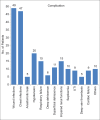Risk-Adjusted Analysis of Patients Undergoing Emergency Laparotomy Using POSSUM and P-POSSUM Score: A Prospective Study
- PMID: 31007512
- PMCID: PMC6452761
- DOI: 10.4103/njs.NJS_11_18
Risk-Adjusted Analysis of Patients Undergoing Emergency Laparotomy Using POSSUM and P-POSSUM Score: A Prospective Study
Abstract
Background: Comparison of operative morbidity rates after emergency laparotomy between units may be misleading because it does not take into account the physiological variables of patients' conditions. Surgical risk scores have been created, and the most commonly used is the Physiological and Operative Severity Score for the enumeration of Mortality (POSSUM) or one of its modifications, the Portsmouth-POSSUM (P-POSSUM), usually requires intraoperative information.
Objective: The objective of this study is to evaluate the POSSUM and P-POSSUM scores in predicting postoperative morbidity and mortality in patients undergoing emergency laparotomy.
Methodology: This is a prospective, cross-sectional, and hospital-based study that was conducted at J.L.N. Medical College and Hospital, Ajmer, Rajasthan, India, from April 2017 to December 2017. Adult patients who presented at the causality and underwent emergency laparotomy were included in the study. Observed and predicted mortality and morbidity were calculated using POSSUM and P-POSSUM equations, and statistical significance was calculated using Chi-square test.
Results: A total of 100 patients were included in this study, with a mean age of 42.83 ± 18.21 years. The observed (O) mortality was 12 (12.0%), while POSSUM predicted 40 (40%) and P-POSSUM 27 (27%). The O/E ratio for POSSUM was 0.29 and for P-POSSUM was 0.44, and this means that they both overestimate mortality. When the results were tested by Chi-square test, the P value was found to be 0.55 and 0.85 for POSSUM and P-POSSUM, respectively, which showed no significant correlation for observed and expected mortality. The observed morbidity was 69 (69%), while POSSUM expected morbidity was 79 (79%), O/E ratio is 0.87, and this again overestimates the morbidity. POSSUM is overpredicting the rate of morbidity, and test of correlation showed no significance with P = 0.75.
Conclusion: POSSUM and P-POSSUM were found to overestimate mortality and morbidity in our patient's population.
Keywords: Observed morbidity; Physiological and Operative Severity Score for the enumeration of Mortality and Portsmouth-Physiological and Operative Severity Score for the enumeration of Mortality; observed mortality; operative score; physiological score; predicted morbidity; predicted mortality.
Conflict of interest statement
There are no conflicts of interest.
Similar articles
-
POSSUM and P-POSSUM for risk-adjusted audit of patients undergoing emergency laparotomy.Br J Surg. 2004 Apr;91(4):500-3. doi: 10.1002/bjs.4465. Br J Surg. 2004. PMID: 15048756
-
Comparison of POSSUM and P-POSSUM for risk-adjusted audit of patients undergoing emergency laparotomy.Ulus Travma Acil Cerrahi Derg. 2009 Jan;15(1):19-22. Ulus Travma Acil Cerrahi Derg. 2009. PMID: 19130334
-
Predictive Performance of NELA Versus P-POSSUM Mortality Scores: Are We Underestimating the Risk of Mortality Following Emergency Laparotomy?Cureus. 2022 Dec 23;14(12):e32859. doi: 10.7759/cureus.32859. eCollection 2022 Dec. Cureus. 2022. PMID: 36694527 Free PMC article.
-
Risk-adjusted scoring systems in colorectal surgery.Int J Surg. 2011;9(2):130-5. doi: 10.1016/j.ijsu.2010.10.016. Epub 2010 Nov 5. Int J Surg. 2011. PMID: 21059414 Review.
-
The accuracy of pre-operative (P)-POSSUM scoring and cardiopulmonary exercise testing in predicting morbidity and mortality after pancreatic and liver surgery: A systematic review.Ann Med Surg (Lond). 2020 Dec 28;62:1-9. doi: 10.1016/j.amsu.2020.12.016. eCollection 2021 Feb. Ann Med Surg (Lond). 2020. PMID: 33489107 Free PMC article. Review.
Cited by
-
Audit of pain management following emergency laparotomies in cancer patients: A prospective observational study from an Indian tertiary care hospital.Indian J Anaesth. 2020 Jun;64(6):470-476. doi: 10.4103/ija.IJA_45_20. Epub 2020 Jun 1. Indian J Anaesth. 2020. PMID: 32792710 Free PMC article.
-
Emergency hernia repair in the elderly: multivariate analysis of morbidity and mortality from an Italian registry.Hernia. 2022 Feb;26(1):165-175. doi: 10.1007/s10029-020-02269-5. Epub 2020 Jul 31. Hernia. 2022. PMID: 32737706 Free PMC article.
-
Morbimortality assessment in abdominal surgery: are we predicting or overreacting?BMC Surg. 2022 Jan 18;22(1):19. doi: 10.1186/s12893-021-01455-1. BMC Surg. 2022. PMID: 35042495 Free PMC article.
-
Comparative evaluation of P-POSSUM and NELA scores in predicting 30-day mortality following emergency laparotomy: A prospective observational study.Turk J Surg. 2025 Feb 27;41(1):56-60. doi: 10.47717/turkjsurg.2025.6645. Turk J Surg. 2025. PMID: 40012281 Free PMC article.
-
Development and validation of an EHR-based risk prediction model for geriatric patients undergoing urgent and emergency surgery.BMC Anesthesiol. 2025 Jan 27;25(1):33. doi: 10.1186/s12871-024-02880-4. BMC Anesthesiol. 2025. PMID: 39865251 Free PMC article.
References
-
- Cook TM, Day CJ. Hospital mortality after urgent and emergency laparotomy in patients aged 65 yr and over. Risk and prediction of risk using multiple logistic regression analysis. Br J Anaesth. 1998;80:776–81. - PubMed
-
- Hag MZ, Ahmed N, Nasir II. Surgical audit of emergency surgery with the POSSUM system. J Med Sci. 2012;20:116–8.
-
- Copeland GP, Jones D, Walters M. POSSUM: A scoring system for surgical audit. Br J Surg. 1991;78:355–60. - PubMed
-
- Ng KJ, Yii MK. POSSUM – A model for surgical outcome audit in quality care. Med J Malaysia. 2003;58:516–21. - PubMed
LinkOut - more resources
Full Text Sources
Miscellaneous


